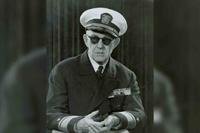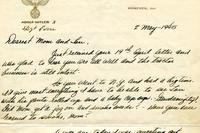The grieving crew of the destroyer Walke and the 14-year-old Japanese girl had both suffered devastating loss in war, but they came together to heal and, decades later, joined in creating a lasting tribute to peace.
On June 12, 1951, off the east coast of North Korea, a horrific explosion on the port side just below the waterline nearly sank the Walke, killing 26 sailors and injuring 40 in the Navy’s worst loss of the Korean War. Ten of the 26 killed were blown overboard, and their bodies were never recovered.
Somehow, then-Cmdr. Marshall F. Thompson and the crew kept the ship afloat as other destroyers made repeated depth charge runs at solid sonar contacts they suspected was one or two Soviet submarines.
The Walke limped back at three knots (3.5 mph) to Sasebo, Japan, for temporary repairs, and the Navy eventually judged that the ship had been hit by one of the thousands of sea mines supplied by the Soviets to North Korea.
But Thompson and other members of the crew never wavered in their suspicion that a torpedo fired by a submarine almost sent their ship to the bottom.

In Sasebo, the repair dock was next to a field used by the crew to play baseball, and the field adjoined a junior high school. A girl from the school they came to know only as Mitoko was a constant presence, cheering up the sailors with her boundless curiosity and enthusiasm.
Mitoko had lost her family on Aug. 9, 1945, when an atomic bomb named “Fat Man” exploded over Nagasaki. Mitoko’s mother was killed, and her father later died of radiation poisoning. She was what the Japanese called an “atomic bomb orphan.”
Steel plates were welded over the gaping hole in the Walke’s port side, and in July 1951, the Walke set course for Mare Island Naval Shipyard in California for more permanent repairs, but before leaving, Thompson and the crew set up a bank account with a scholarship fund for Mitoko.
She became a nurse and worked for the Red Cross, and as a wife and mother, Mitoko Yamachi reunited in the 1990s with Thompson and other members of the Walke crew in San Diego.
“We did not help Mitoko by paying for her scholarship,” Thompson recalled then. “In fact, she is the one who helped us.”
Ship’s Proud Combat Legacy
The after action reports and investigations to determine what happened to the Walke posed a dilemma for the Navy.
If the ruling was that a torpedo from a Soviet submarine -- and not a mine -- had hit the Walke, it would confirm that a new theater of war had opened just as preliminary peace talks led by Vice Adm. C. Turner Joy were about to begin on July 10, 1951.
At the time, the U.S. had already confirmed that the Soviets had given an “enormous number” of mines to the North Koreans, and there was “considerable concern among U.S. Navy commanders in the Far East that Soviet submarines were a serious potential threat,” according to a January 2021 posting by the Naval History and Heritage Command.
“As a result, U.S. Navy rules of engagement permitted immediate attack on any unknown submarine contacts in the vicinity of U.S. forces,” the posting said.
The Navy’s ruling in the case of the Walke was that the after action reports and investigations would remain top secret, but no official reason was given for keeping the findings under wraps.
Another possible consideration for Navy officials was that they were dealing with an incident that had caused death and major damage to a warship whose name had become a combat legend in the destroyer fleet.
The first USS Walke (DD-34) was a Paulding-class destroyer named for Civil War Union Rear Adm. Henry Walke, with the ship serving in World War I.
The second Walke (DD-416), a Sims-class destroyer, was sunk on Nov. 15, 1942, by a torpedo and salvos from a Japanese flotilla during a harrowing night battle off Guadalcanal.
“Total killed or missing in action were six officers and 76 enlisted,” Lt. W.J. Collum Jr., one of the Walke’s officers, wrote in his after action report. Many of the survivors spent the night clinging to the detached bow of the Walke.
A new Walke (DD-723), a 376-foot Sumner-class destroyer with an assigned crew of more than 300, was commissioned in January 1944 and provided cover for the D-Day landings in Normandy on June 6, 1944.

The Walke then was ordered to the Pacific, where on Jan. 6, 1945, while supporting the invasion of Luzon in the Philippines, the destroyer was attacked by four Japanese kamikaze aircraft.
Two planes were shot down by the destroyer’s deck guns and a third was hit several times before crashing in flames into the bridge, severely burning and wounding Cmdr. George F. Davis, the ship’s captain. Davis would posthumously be awarded the Medal of Honor.
Remarkably, the Walke continued operating and supported the landings on Luzon on Jan. 9, 1945, before going in for repairs. The Walke then served during the vicious battle to take Okinawa in May 1945.
Possibly One Sub, Maybe Two
After the war, the Walke was part of the fleet supporting the atomic tests in the Marshall Islands and then was decommissioned into the reserve fleet in San Diego in June 1947.
But on Oct. 5, 1950, the Walke was recommissioned for service in Korea under the command of Cmdr. Marshall F. Thompson. On June 12, 1951, the ship was part of Task Force 77, one of 11 destroyers serving as a screen for the carriers Bon Homme Richard and Princeton, the battleship New Jersey and the cruiser Helena on a calm sea morning about 60 miles off the North Korean port of Wonsan.

One of the sailors aboard the Walke was 18-year-old Charles Truman Smith, who would become a seaman 1st class before leaving the Navy. He died in 2018.
His son, Greg Smith of Macon, Georgia, said in interviews with Military.com that his father thought it was likely that a mine had damaged the ship, but others in the crew, including Thompson, firmly believed it was a torpedo.
Smith decided he wanted to know more and began a years long pursuit of details about the explosion that left the Walke scarred.
He initially was told in a letter from the National Archives and Records Administration (NARA) that the only public record file on the Walke incident was a memorandum which lacked any new details, but said the damage to the Walke was either from a mine or a torpedo.
Through Freedom of Information Act requests, Smith eventually received several declassified documents that had been filed shortly after the explosion. Those reports said the Walke and three other destroyers in the screen made sonar contacts with what the ships believed to be one and possibly two submarines.
The explosion that tore open the aft port side of the Walke occurred at 7:40 a.m., and at 9:31 a.m., the nearby destroyer Bradford picked up a sonar contact but “almost immediately evaluated it as non-submarine,” according to a report from the commander of the destroyer squadron to the chief of naval operations.
Then at 9:40 a.m., the Bradford “re-evaluated contact as possible submarine and made an urgent attack” with depth charges three minutes later and at 9:45 a.m. “reported submarine surfacing in her wake.”
The report added in parentheses that “further questioning revealed that a dark mass about forty-feet long rose to a height of five feet momentarily after Bradford’s initial attack then settled rapidly. This object was not identified positively as a submarine and was re-evaluated as improbable.”
For the next two hours after the explosion, the Walke picked up sonar contacts “on objects which were classified as fish,” according to the after action report filed by Thompson on June 19, 1951.
But at 10:38 a.m., the Walke picked up a “firm sonar contact,” and all indications “contributed to a classification of ‘submarine,’” Thompson’s report said. “The contact was turned over to the (destroyer) Hubbard who picked it up quickly and moved in to attack” with depth charges.
“Several attacks were made by Hubbard on that contact, which was classified as a ‘submarine’ over voice radio,” and the attack was joined by the destroyer O’Brien. “The outcome of these attacks is not known,” Thompson wrote, but the Hubbard reported an oil slick and debris on the water after a depth charge run.
Another after action report to the chief of naval operations filed on Sept. 4, 1951, summarized that “The available evidence does not indicate conclusively what type of agent damaged the Walke.”
The final report obtained by Greg Smith on the Walke incident was from Rear Adm. Ralph Ofstie, a highly respected officer who earned the Navy Cross in the Battle of Leyte Gulf in World War II.
Ofstie’s report dated Sept. 13, 1951, stated that the damage to the Walke “was most probably caused by a floating mine. Although the mine could possibly have been laid by a submarine, it is felt that it probably originated from minefields along the northeastern coast of Korea and was carried to the area by ocean currents.”
Navy records show that there were at least two other times during the Korean War when U.S. destroyers used depth charges to attack a suspected submarine, and both incidents involved the destroyer McKean, but in neither case did the Navy ever confirm a Soviet submarine was present.
Five Navy ships – four minesweepers and an ocean tug – were sunk by mines during the the overshadowed naval campaign off Korea with a total loss of 31 sailors, according to Navy records and a list of damaged or sunk ships compiled by NHHC.

In addition to the Walke, four other destroyers were struck by mines, killing a total of at least 27. The records also show that more than 80 other Navy warships, including the battleships New Jersey and Wisconsin, were damaged by fire from shore batteries.
Reunited in San Diego
After Korea, the Walke served several tours off Vietnam before being decommissioned in 1970.
Through three wars, the destroyer had earned 17 battle stars – six in WWII, four for Korea and seven off Vietnam – to make the ship one of the most decorated in Navy history.
The crew and Cmdr. Thompson lost contact with Mitoko after the war. Thompson, who retired as a captain, later learned that Mitoko had tried several times to write to him, but she apparently had a wrong address and her letters were always returned.
Then by happenstance, Thompson attended a tea ceremony at the Japanese Friendship Garden in San Diego’s Balboa Park. He told the staff the story of Mitoko. Could they help in finding out what happened to her?

In an interview with Military.com, and in a posting to the Friendship Garden’s website, Mark Halverson, then a systems engineer for Northrop Grumman and a docent, or guide, at the garden, told of the emotional reunion of the orphan girl with Thompson and other surviving Walke crew members.
The staff had located Mitoko Yamachi in Tokyo, and “by this time, Mitoko was a successful nurse working for the Red Cross, and was married. They had a grown son and daughter,” Halverson wrote.
“In August of 1993, after 42 years, Mitoko and her husband reunited at the Japanese Friendship Garden in San Diego for a reunion with Captain Thompson and several of the USS Walke shipmates,” Halverson said in his account.
Mitoko and her husband returned several times for reunions with the Walke crew, for Capt. Thompson’s funeral in 2001 and for the 50th anniversary of the near-sinking of the Walke off the east coast of Korea.
After the 1993 reunion, Mitoko wrote a book about how “the selfless acts of the crew of the USS Walke” changed her life, according to Halverson.
Mitoko, Thompson’s widow and several members of the Walke crew also donated to a fund to have cherry trees planted at the Friendship Garden, which now bloom each year in a lasting tribute to peace.
In Japan, the story of Mitoko and the Walke has become emblematic of the efforts to renew bonds of friendship that had been sundered by World War II.
On Nov. 9, 2018, Rear Adm. Akira Saito of the Japanese Maritime Self-Defense Forces went in uniform to El Camino cemetery in San Diego to pay respects at Thompson’s grave.
In an article posted on the website of the U.S. Naval Air Facility in Atsugi, Japan, Saito wrote that he had been wishing to visit the grave since he learned of “the heartwarming story of Ms. Mitoko Yamachi’s interaction with USS Walke crew in Sasebo 67 years ago.”
In his visit to Thompson’s grave, Saito wrote that he had “renewed my feeling that the spirit of mutual support is the very foundation of the Japan-U.S. alliance. As the epitaph on Captain Thompson’s grave is, ‘He will live in our hearts forever,’ so the goodwill of Captain Thompson and USS Walke crew members lives in our Japanese hearts all the time.”

Richard Sisk can be reached at Richard.Sisk@Military.com.
Want to Learn More About Military Life?
Whether you're thinking of joining the military, looking for post-military careers or keeping up with military life and benefits, Military.com has you covered. Subscribe to Military.com to have military news, updates and resources delivered directly to your inbox.
















